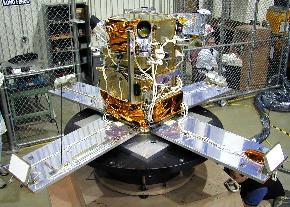
 | Home | Bursts | Publications | Ops & Status | Goals | Team | History | Spacecraft | Instruments | Ground | Alerts | FAQ | Gallery |

|

|
| HETE-2 at Mass Properties Testing
The HETE-2 spacecraft's mass properties (moments of inertia about the three spacecraft axes) were measured at a special facility at Goddard Space Flight Center. In this mass properties test, the spacecraft is set up in its flight state, with solar panels deployed and then spun around its z-axis. Small torques are applied to the spacecraft, and the reaction of the spacecraft to the torques is tells us about the mass distribution inside the spacecraft. These tests are run as a confirmation of the calculated value: by weighing each piece of the spacecraft individually and knowing how the pieces are put together, a very accurate estimate of the mass properties can be made.
These two pictures show different views of the HETE-2 spacecraft
in its deployed state: see the
spacecraft page for more details.
|

|
| HETE-2 on the Pegasus Rocket at Vandenberg AFB (side view)
This side view of the HETE-2 spacecraft, completely assembled and
mounted to the third stage of the Pegasus XL rocket, was taken
January 6, 2000.
Protective hardware (lens caps and plastic shields for the solar
panels) are visible on the satellite: they will be removed just
before the installation of the fairing.
|

|
| HETE-2 on the Pegasus Rocket at Vandenberg AFB (front view)
This front view of the HETE-2 satellite on the Pegasus launcher has an excellent view of the HETE-2 science instruments (see the instrument page for details). As in the picture above, the protective covers over the boresight cameras and SXCs are visible.
Note the plastic sheet in the background: this is the "wall" of
the clean tent set up around the spacecraft while it is on the
rocket. Also visible in the background is the rear structure of
the rocket itself.
|